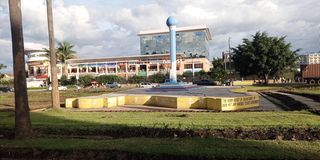Rich history behind Nakuru's iconic KFA roundabout

Photo of KFA roundabout in Nakuru city taken on 23 April 2025.
As you drive past the KFA roundabout, it might seem like just another traffic circle—nothing particularly special at first glance. Typically, its border is lined with neat, green knee-high plants and well-tended grass at the centre.
Lately, however, it’s undergoing a facelift. The old flowers have been cleared out, and fresh blooms are beginning to sprout, signalling a new phase in its landscaping.
But a closer look reveals something more—a white and sky blue pillar resembling a baton, mounted on a platform edged in yellow. It’s not just a decorative piece; it’s a monument steeped in history.
John Githanga, a long-time resident of Nakuru, tells Mtaa Wangu that this roundabout is home to one of the many monuments erected across major towns during President Daniel Arap Moi’s leadership.
“This is one of the many monuments built across the country during the Nyayo Era,” he says.
The structure was built in 1988 to commemorate Kenya’s 25th year of independence and 10 years of Moi’s presidency.
Githanga, who was part of the construction team, explains that the monument was designed by a Nakuru-based architect. It features a base with the map of Kenya, a central baton-like pillar, and two side pillars topped with white doves.
“The baton represents the Fimbo ya Nyayo—Moi’s symbolic baton, which he always carried with him as a sign of his commitment to defending the people of Kenya,” he explains.
The white doves perched above the map represent peace throughout the country.
The roundabout leads to Kabarak, the final resting place of Kenya’s second President.
Interestingly, the monument’s colours—sky blue and white—match those of Mount Kenya University, the institution currently managing the roundabout as part of its corporate social responsibility (CSR) efforts.
The upkeep of roundabouts in Nakuru is often entrusted to different organizations as part of their CSR contributions.


